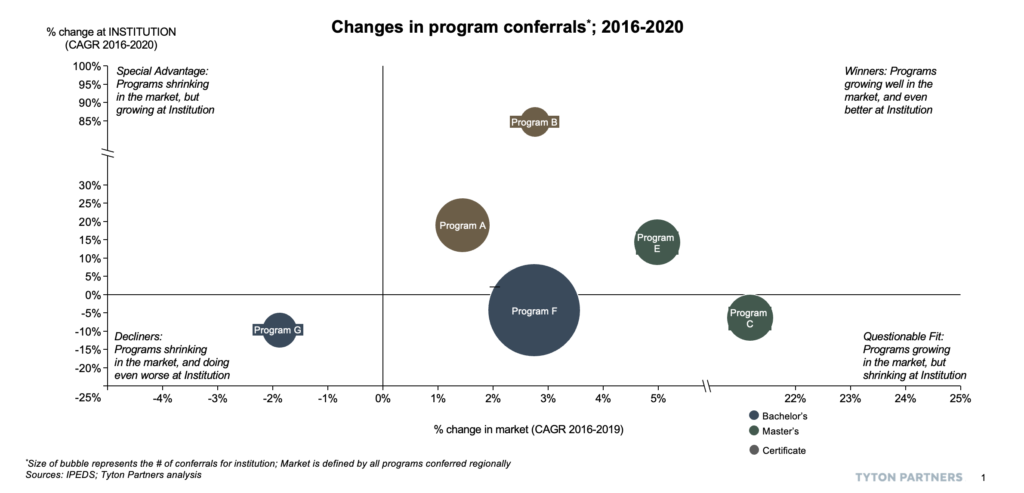Catalytic Capital: From Recognition to Action in Education-to-Workforce Investing
July 8, 2025 BlogThe education-to-workforce pipeline is under pressure – and changing fast. The World Economic Forum notes that employers around…
In the face of declining undergraduate and graduate enrollment, taking a proactive approach to program portfolio planning is critical in order to align with changing regional workforce dynamics, ensure student success, and ultimately secure financial sustainability.
According to National Clearinghouse data, there were 9.4% or 1.4 million fewer undergraduate students enrolled in higher education as of spring 2022 than in spring 2020. Graduate/professional students enrollment grew modestly over this same period with 100,000 more students enrolled. The factors driving this overall enrollment decline are multi-faceted and include the pandemic shock to enrollment, changing student perceptions of higher education, changes in delivery preferences, and a historically strong labor market. In this context, ongoing calibration and consideration of program portfolios is essential.
In our work, we find the institutions best able to serve learners and support institutional sustainability balance market, mission, and margin in their portfolio planning:
Examining market growth vs. institutional growth across disciplines and credentials (as seen in the example below,) can enable a clear view into how programs are performing relative to competitors and open lines of inquiry into where, why, and how institutional performance is leading or lagging the market and where targeted actions may be required.

As any investor prospectus will tell you, “past performance is no guarantee of future results.” The same is true of enrollment patterns and student behaviors. When comparing past market and institutional performance through the lens of degree conferrals and enrollment we are viewing “lagging indicators,” which are markers of student decisions made anywhere from 2-6 years ago. These lagging indicators must be coupled with leading indicators from a variety of critical sources –regional workforce data projections, feedback and input from regional and national employers in key sectors, and analysis of student inquiries and new enrollment. Forward-looking, relevant employment-oriented pathways must be a core element of program portfolio planning.
Enrollment is only one part of the equation, of course. Understanding the experience and outcomes of students by programs, overall and disaggregated by factors including income, race, gender, age is another critically important step in assessing the ROI of programs across the portfolio. Are students making timely progress and completing? Are students being employed in jobs well suited to their investment? Are they experiencing appropriate economic mobility? Do they report strong satisfaction with their experience? Are these outcomes distributed equitably across race, gender and family background? Transparent interrogation of these questions enables effective planning and problem solving among both curricular and co-curricular (e.g., advising, career) leaders across all student-facing functions.
Hybrid learning models are demonstrating not only greater access to higher education pathways, but also greater attainment and success. For example, recent findings from the Institute for Higher Education at the University of Florida suggest that Black and Hispanic community college students and those who come from low-income backgrounds who take some, but not all, of their courses online increase their likelihood of completing a degree. Modality can play a critical role in supporting student completion, and intentionally ensuring that hybrid and online learning strategies are being deployed across programs is key.
The bottom-line contribution across programs necessarily varies. Clinically-based or lab-based programs require higher costs, those that are smaller have lower margins, and others may be intentionally operated at a loss in order to ensure that the educational outcomes core to the institutional mission are experienced by all students. Understanding the relative financial contribution of various programs over time is key to managing the overall portfolio – both from a programmatic quality and financial sustainability perspective.
These are just a few of the critical steps we support institutions in undertaking to calibrate the academic portfolio and integrate market, mission, margin. When these steps are well taken, key strategic decisions become clearer in areas such as:
As you consider this work at your institution, please feel free to reach out to us to discuss how we can support your work.